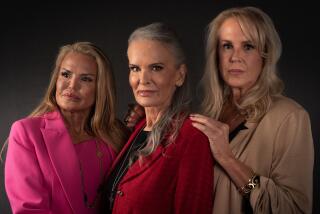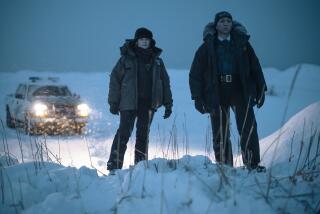Producers hope to take ‘Bonnie and Clyde’ to the bank
DONALDSVILLE, La. — Late one evening last spring in this struggling but picturesque river town about an hour west of New Orleans, the never-ending saga of Bonnie and Clyde took an unexpectedly fiery twist.
Vintage 1930 Fords roared down the town’s main drag in a cops-and-robbers chase, men leaning out car windows, guns blazing. Then, just as the director Bruce Beresford was about to call action for another take, one idling vehicle’s engine suddenly burst into flames. A cluster of crew members raced over to douse the fire.
“These cars from 1930 were just a nightmare,” Beresford, a native Australian perhaps best known for his feature version of “Driving Miss Daisy,” recalled later. “Sometimes you’d call action and there’d be three or four cars there, and none of them would move. They couldn’t start them.”
Depression-era automotive machinery may not be reliable, but three cable networks are betting that the period’s most enduring criminal tale will be. The $15-million, four-hour miniseries “Bonnie and Clyde: Dead and Alive” — yet another retelling of the crime spree of doomed lovers Bonnie Parker and Clyde Barrow, with “The Borgias” costar Holliday Grainger and “Into the Wild” star Emile Hirsch in the title roles — will air for two consecutive nights starting Sunday.
In an extraordinary test for “event TV,” the show will air simultaneously on A&E, Lifetime and History, the last of which in 2012 turned its historical epic “Hatfields & McCoys” miniseries into a surprise hit, with more than 14 million viewers for the finale. “Bonnie and Clyde’s” producers are hoping they can deliver that kind of ratings with their spin on another pair of familiar names.
“It really brought back the miniseries,” Craig Zadan, executive producer of “Bonnie and Clyde” with his business partner, Neil Meron, said of “Hatfields.”
Together Meron and Zadan have made such hits as the features “Hairspray” and “Chicago” and are also behind NBC’s recent live version of “The Sound of Music” with Carrie Underwood. “‘Bonnie and Clyde’ probably wouldn’t have gotten pushed through so quickly and so forcefully if ‘Hatfields’ hadn’t been such a huge success,” Zadan said.
Even so, getting the movie made required nearly as much determination as that shown by Frank Hamer, the relentless ex-Texas Ranger who pursued Bonnie and Clyde in real life and is played by Oscar winner William Hurt in the film. The crew was under intense pressure to film a story with dozens of locations and plenty of gun battles, with a budget that for many studio features wouldn’t even cover the cast salaries. Beresford, a persistent self-critic, complains even now that he needed more shooting time.
Then too there is the matter of the historical record, always a tricky subject in docudrama. Although Meron boasts of the “incredible amount of research” that writers Joe Batteer and John Rice did in assembling the script, the author of a recent Bonnie and Clyde biography said that the movie gets important facts wrong and invents many scenes that likely never happened.
PHOTOS: Leading ladies of the fall TV season
For all that, the producers promise their take will keep the story relevant for a new generation, especially in its portrayal of Bonnie Parker as a fame-thirsty wannabe. The first reality TV star, in Zadan’s thinking.
Finding Bonnie
Marilyn Vance stood in her wardrobe trailer leafing through photos. There were pictures of Grainger in all kinds of poses as Bonnie. Wearing a knitted cap at a jaunty angle. Cocking her hips in a long skirt. Smiling in a broad-brimmed hat and glamorous sunglasses.
As a veteran costume designer, Vance has sheathed some of the most famous bodies in Hollywood. For “Die Hard,” she ripped up 17 T-shirts for Bruce Willis (one of the shirts now resides in the Smithsonian). She poured Julia Roberts into that form-fitting red gown with the white gloves in “Pretty Woman.” She persuaded a reluctant Molly Ringwald to don the memorable “granny chic” prom dress in “Pretty in Pink.”
Vance, a quirky and energetic woman with a bottomless passion for style, paused at a close-up of Grainger mugging, scrunching her face for the camera. “She’s just adorable,” Vance said.
For “Bonnie and Clyde,” Vance combed costume houses and vintage shops, often stuffing her multiple trailers with genuine clothing from the early 1930s rather than trying to fashion replicas. It was all part of a painstaking effort to re-animate an era that exists in the memories of only the oldest Americans.
The actors also wanted to get everything just so. The 25-year-old Grainger, who hails from the British city of Manchester and had never spoken with an American accent in a role before, had to take on Parker’s East Texas twang. She studied with dialect coaches but was wary of overdoing the accent. So she carefully listened to the performances of a genuine Texan who didn’t need to fake it.
“I kind of based my voice on Sissy Spacek,” she said with a laugh, alluding to the Oscar winner who shot to fame in “Carrie” and “Coal Miner’s Daughter.”
PHOTOS: Behind the scenes of movies and TV
Authenticity is a relative concept, though, when it comes to a tale told as often as Bonnie and Clyde’s.
The real outlaws came from dirt-poor families. Clyde’s family was so destitute it had to sleep under a wagon after it moved to Dallas. Bonnie’s father died when the girl was small and her mother (played by Holly Hunter) struggled to get by working in a garment factory.
Clyde hardly seemed destined for international notoriety. As a young man, he stole turkeys with his brother, Buck, later moving up to knocking over gas stations and hot-wiring cars. His hobbies were playing music (saxophone, guitar) and driving fast. But after being sent to Texas’ notoriously tough Eastham Prison Farm in 1930, Clyde transformed into an angry, violent criminal. He beat to death another inmate who had raped him — the first of many subsequent murders. “A rattlesnake” is how another prisoner described the Clyde who was paroled in early 1932.
Bonnie was a good student — she especially liked writing poetry — but dropped out of high school to marry at age 15. That union lasted only a couple of years, at which point Bonnie was taking orders in a diner. She met Clyde around the time he was paroled. Clyde assembled a gang of cons within a few weeks, with Bonnie increasing her participation in the mayhem as the months went by.
The duo’s legacy
In the decades since, their story has inspired a Broadway musical, numerous books and countless songs (including Jay-Z and Beyonce’s hit “’03 Bonnie & Clyde”).
It also led, as any student of the genre knows, to the famous 1967 “Bonnie and Clyde,” director Arthur Penn’s take starring Warren Beatty and Faye Dunaway, which sharply divided critics. The overall violence of Penn’s movie — and in particular the shockingly bloody, meticulously edited finale — repelled many. The critic Joe Morgenstern dismissed the movie as a “squalid shoot-’em-up for the moron trade” (he later recanted).
But the romanticized view of Bonnie and Clyde as young nonconformists rebelling against staid, homespun America thrilled the late-’60s counterculture. It also helped launch a new wave of American filmmakers with personal, idiosyncratic visions, leading to such later outlaw classics as “Easy Rider” and “The Godfather.”
PHOTOS: Celebrities by The Times
“I think Abbie Hoffman thought of himself as Clyde Barrow,” said Jeff Guinn, author of the 2009 book “Go Down Together: The True, Untold Story of Bonnie & Clyde,” which Hirsch said he used for background in understanding Barrow and the historical context.
Guinn has seen the movies by Penn and Beresford and said both are too filled with twisted facts and flights of fancy to qualify as even close to the “real story.” “Both should be considered entertainment,” he said.
The new movie has Clyde crashing a wedding reception where he sees Bonnie — the bride — for the first time. It’s a romantic notion, but in truth, they met at a more routine party. Bonnie’s husband — a small-time criminal himself — had already left her by then, Guinn said. The real Bonnie loved movies, but she was never, as the miniseries shows, rejected by Columbia Pictures after she wrote them hoping to be a screen star.
Bonnie was a willing accomplice to Clyde, Guinn said, but was hardly the driven, machine-gun-waving moll depicted by Grainger. The real Parker was clumsy with firearms and nearly shot off her foot once during a misadventure in a hotel, according to Guinn.
“They were terrible robbers,” Guinn said. “The people they robbed were mostly mom-and-pop grocers. The times they tried to rob banks they were mostly foiled.”
In any event, the emotional truth rather than the literal one was what the filmmakers were after. “We were trying to bring some emotional nuance to the story,” Hirsch explained. “Why would they possibly do this? What motivated that? I feel like answering those questions was pretty important to the film.”
Rob Sharenow, the Lifetime executive vice president who helped shepherd the miniseries, said the filmmakers deliberately chose to make Bonnie a “driver” of the tale — “much more than Clyde was,” he said. Grainger portrays her as a Lady Macbeth-in-waiting, an ambitious, emotional girl subject to panic attacks who becomes the bank robber who barks, “Don’t mess with Bonnie and Clyde!”
ON LOCATION: Where the cameras roll
What the real Bonnie and Clyde did have was good timing — and a good backstory. One day in March 1933, the year after their multi-state crime ramble began, they posed for roadside photographs in front of a stolen Ford V-8 convertible (license plate fully visible). Police found the roll of undeveloped film the following month during a raid on their Missouri hideout. Soon news outlets blasted countrywide a photo of Parker chomping on a cigar, pistol in right hand, left foot resting on the Ford’s bumper. Another had the petite Bonnie balanced on Barrow’s left arm. Both were smiling as if they’d just won a prize at the fair.
That these two road-tripping hoodlums were photogenic lovers who by all accounts were crazy about each other made the story irresistible. As Guinn said, “It’s ‘Romeo and Juliet’ with guns.”
Back to the Depression
Baz Luhrmann’s recent adaptation of “The Great Gatsby” reignited curiosity about the Jazz Age, so it’s possible that “Bonnie and Clyde” could do the same for the Depression and its colorful cast of criminals who became known as “Public Enemies.”
Brad Adgate, an analyst for ad firm Horizon Media in New York, said “Hatfields” proved the value of miniseries and event programs. For “Bonnie and Clyde,” “I anticipate strong ratings,” he said.
Beresford hopes that’s right, although he remained unsatisfied with what he got during shooting. He insists all his movies seem “wrong” somehow, even his 1980 breakthrough, “Breaker Morant,” now a classic story of the Boer War.
Making “Bonnie and Clyde,” he said, he was disconcerted by “how little time I had to shoot some quite big sequences. Everyone was under financial pressures,” he said. “Sometimes I’d be shooting for a night or a night and a half and I’d think, ‘God, I really need five nights to do this.’ Some of the shootouts are huge.”
It didn’t help matters when cars were catching on fire or failing to start. But that was what the filmmakers signed up for with this particular tale. The production designer Derek Hill — who like Vance worked on “Hatfields” — said he had access to dozens of vehicles from the Depression, thanks to auto clubs in the area.
At least Hill didn’t have to wonder what makes or models to pick. There was just one type of car he needed to find, one vehicle that did one thing that summed up the appeal of the Bonnie and Clyde story as it enters its ninth decade.
“Most everything Clyde stole were Ford V-8s,” Hill explained during a dinnertime break in shooting. “‘Cause they were the fastest on the road.”
More to Read
The complete guide to home viewing
Get Screen Gab for everything about the TV shows and streaming movies everyone’s talking about.
You may occasionally receive promotional content from the Los Angeles Times.







